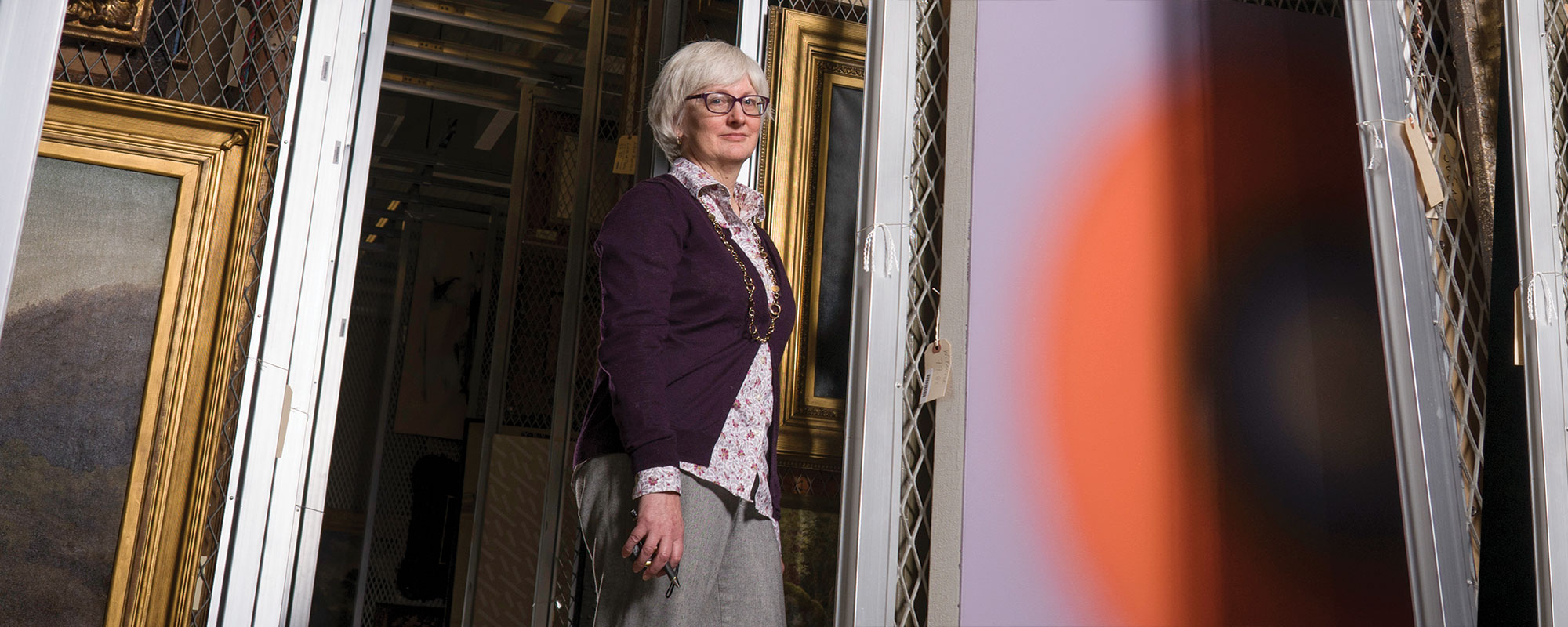When artists Lenka Clayton and Jon Rubin were mining Carnegie Museum of Art’s history for inspiration for their contribution to the 2018 Carnegie International, Elizabeth Tufts Brown, the museum’s associate registrar for the permanent collection and archives, called to their attention the meticulous records of the first 35 years of the venerable exhibition. Documentation of not just all the artworks accepted into the annual show from 1896 to 1931, but all those rejected as well. These little-known details became integral to the pair’s project Fruit and Other Things, which turned each of the 10,632 rejected titles into individual, hand-lettered text paintings that were exhibited and then given away.
For Tufts Brown, the devil—and the delight—is always in the detail. For 24 years, she’s been the keeper of the museum’s historic record—all 2,500 linear feet of letters, sketches, posters, scrapbooks, architectural drawings, clippings, manuscripts, catalogs, books, photographs, videotapes, films, audio recordings, and other ephemera tucked away in the museum’s basement.
“The materials tell the story of the museum, the development of its collections, and aid in the interpretation of works exhibited in the past and today,” says Tufts Brown. “The correspondence is rich with letters from artists, especially those who participated in Carnegie Internationals.”
Museum staff, academics, gallerists, the public—they all turn to her for answers.
“I field scholarly requests for files on ‘X’ artist for their catalogue raisonné. I do internal research that’s needed as we develop exhibitions or fill in gaps for our records,” she notes. “I respond to all kinds of public inquiries—’I saw an exhibition in the 1970s with a work by the Garbage Lady; do you have a photo of it?’”
She revels in the never-ending sleuthing, and the most fun she’s ever had on the chase ended—after a two-year journey—with her confirming that an English country-road scene identified as a Monet and gifted to the Detroit Institute of Arts was actually a fake.
“The curator said it could be an early Monet, but he felt something just wasn’t right about it. He called because the painting had a tag on the back that said Carnegie International,” recalls Tufts Brown. “We get calls like that all of the time; I thought it would be an easy answer.” After going down one rabbit hole after another with the curator, even consulting city street maps to see if it could be traced to an owner in the provenance, through sheer luck she stumbled upon a 1910 catalog with a photograph of the painting—which turned out to be the work of landscape painter Alfred East and clearly labeled as such.
“The signature had been forged to make it a Monet,” says Tufts Brown. “It was wild.”
“Working with the archives builds my relationship with the institution, binds me to it, in a unique way.” – Elizabeth Tufts Brown
Now, as Carnegie Museums plans to mark its 125th anniversary this fall, Carnegie Museum of Art is tapping that thrill-of-the-chase instinct in digging up fresh treasures from the archives. Tufts Brown’s research will inform an upcoming exhibition and an accompanying collections handbook featuring archival surprises that will help bring the museum’s long history to life.
“They told me to bring out all of the good stuff,” says Tufts Brown, laughing.
Although she’s not formally trained as an archivist, when she joined the registrar’s office part time in 1996, she began answering public inquiries and through a labor of love took the archives under her wing. At the time, the archives lived in a dark, dusty space crowded with towering boxes of files, pallets of publications, and cast-off office supplies and computer equipment. Over the years, she’s worked with countless library science interns to reorganize the archives into a professional space.
“Working with the archives builds my relationship with the institution, binds me to it, in a unique way,” says Tufts Brown. “I feel like I know the people who once worked here, as reading their letters brings them to life. They were just doing their part day to day just like we do today, so I see myself as a small part of the whole history of the Carnegie. It’s just like the sign I have posted on the door to the archives, ‘Where Art Comes Alive.’”
Receive more stories in your email
Sign up
